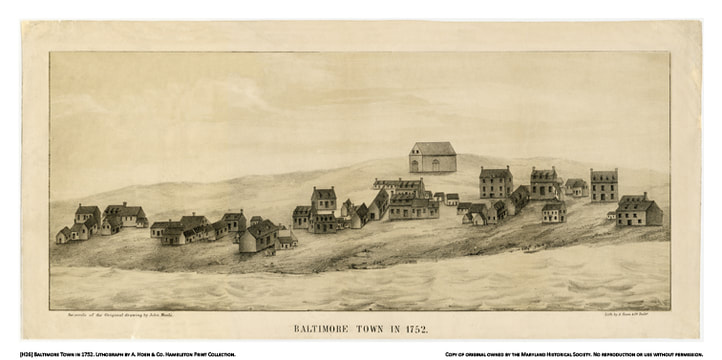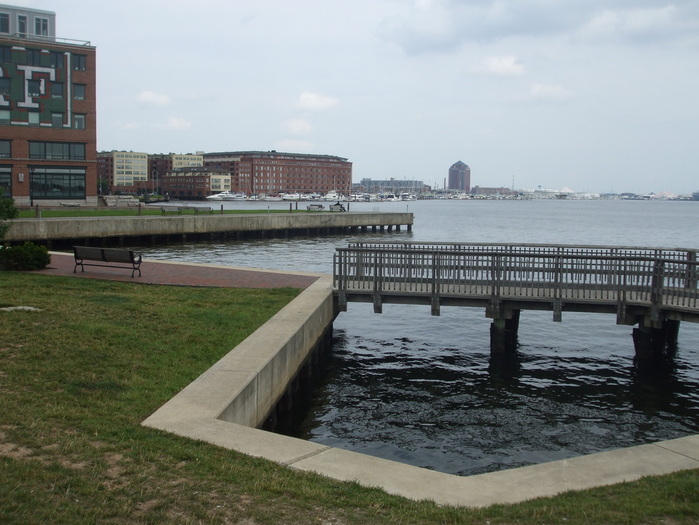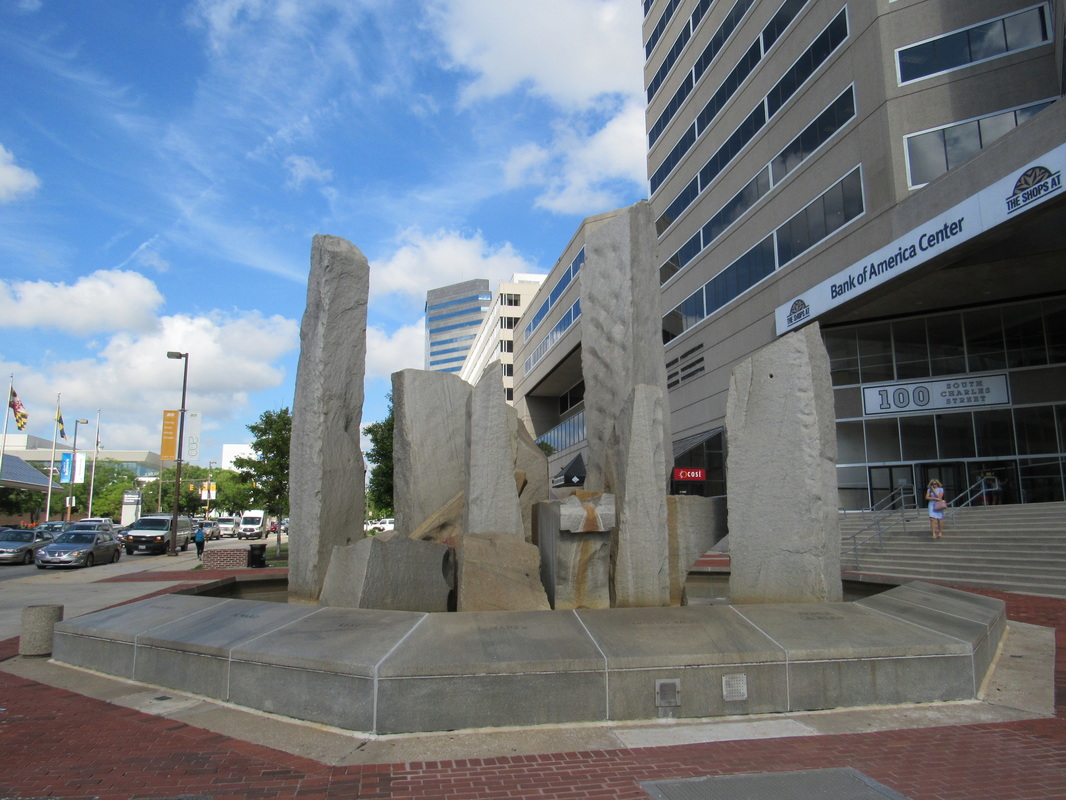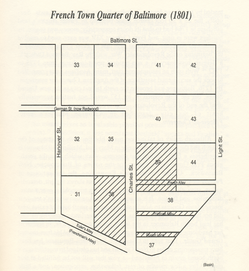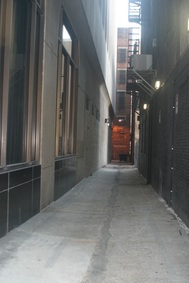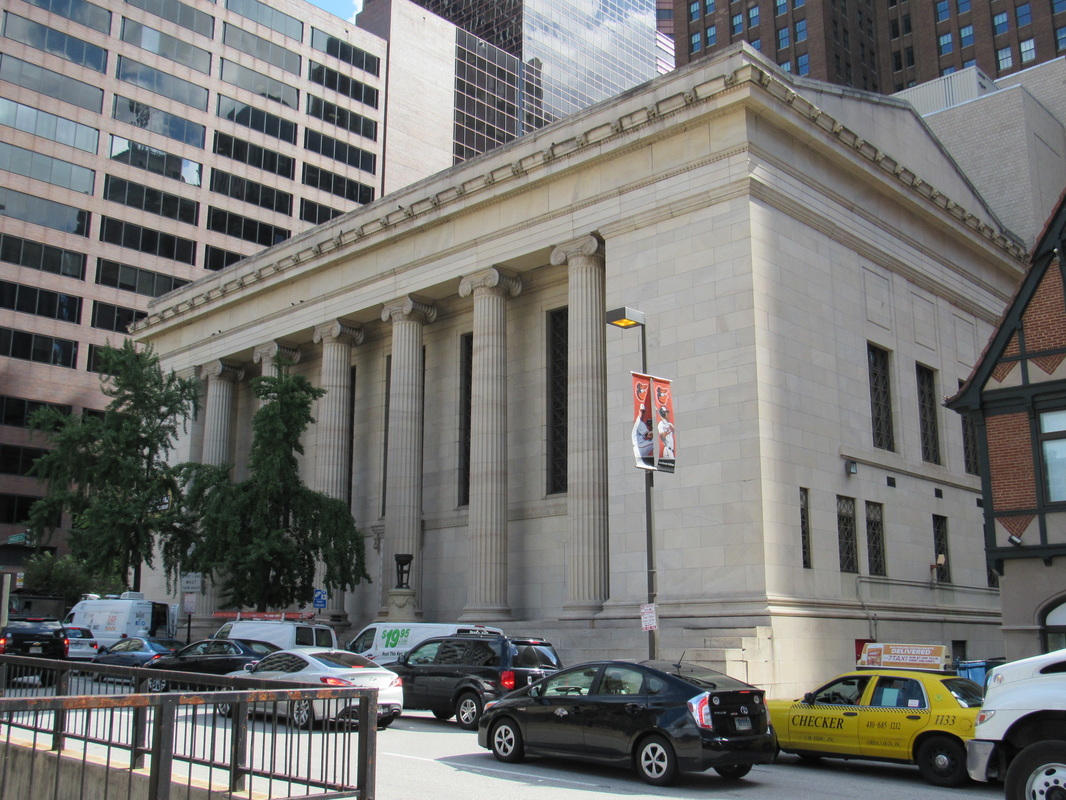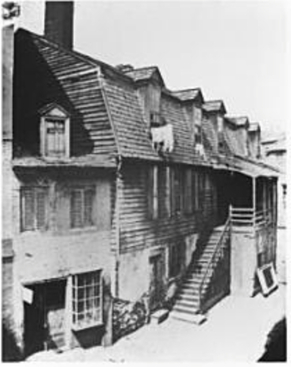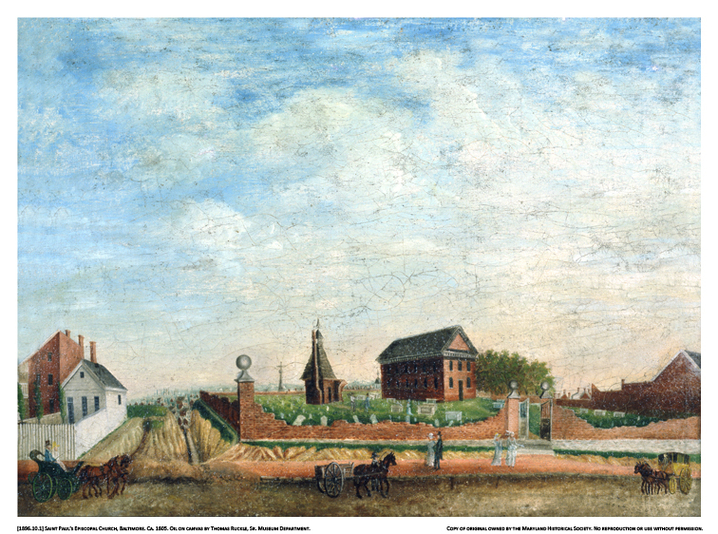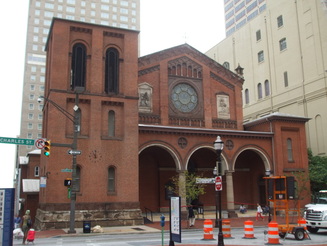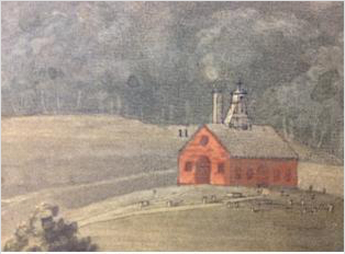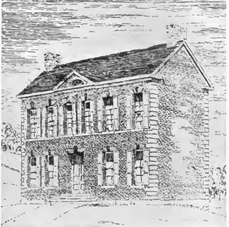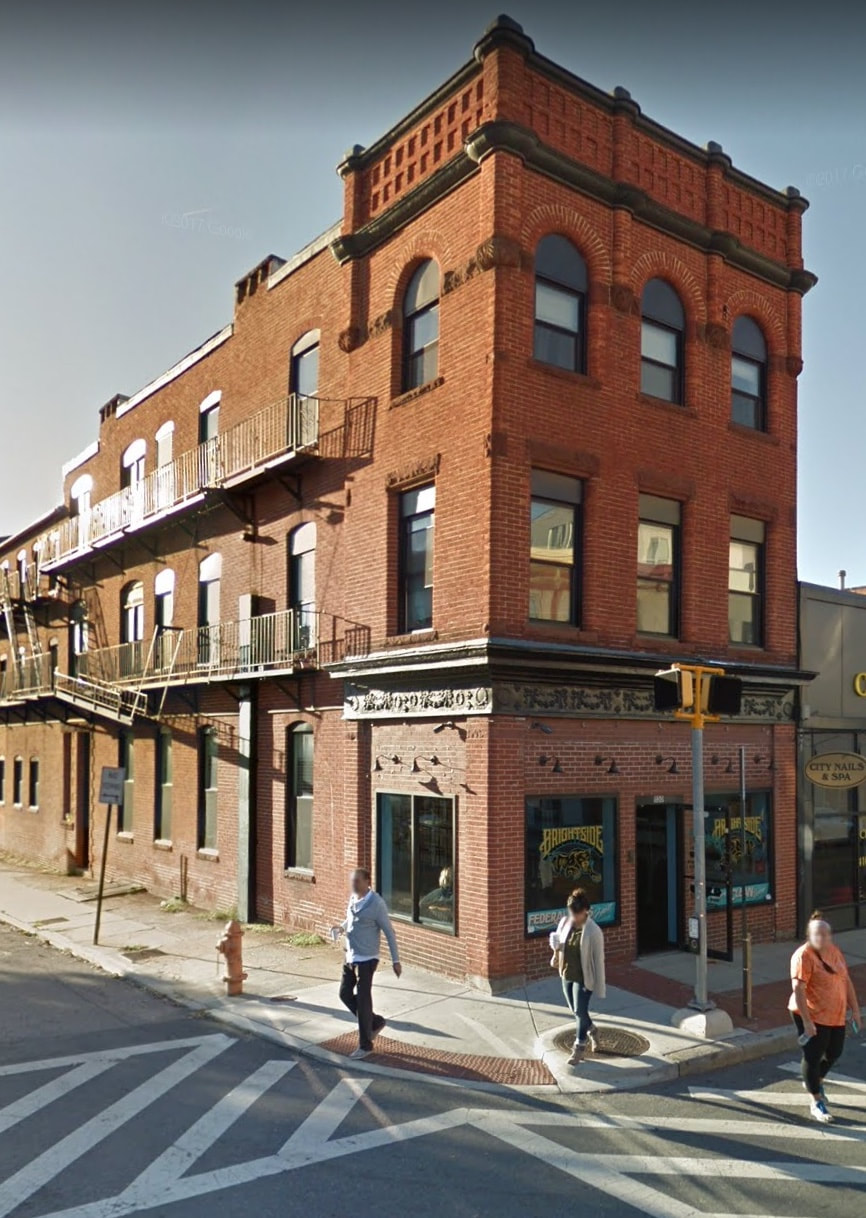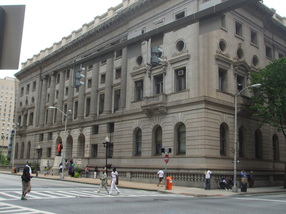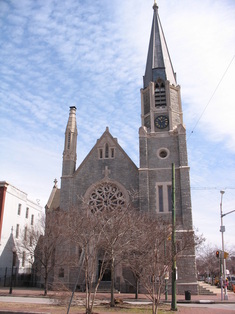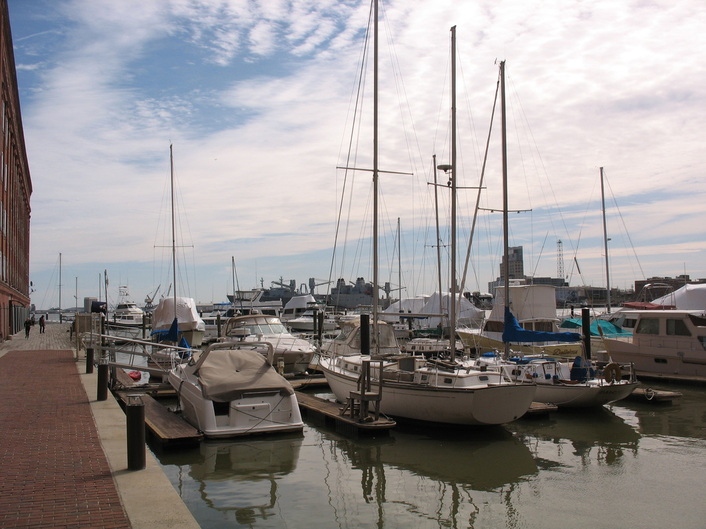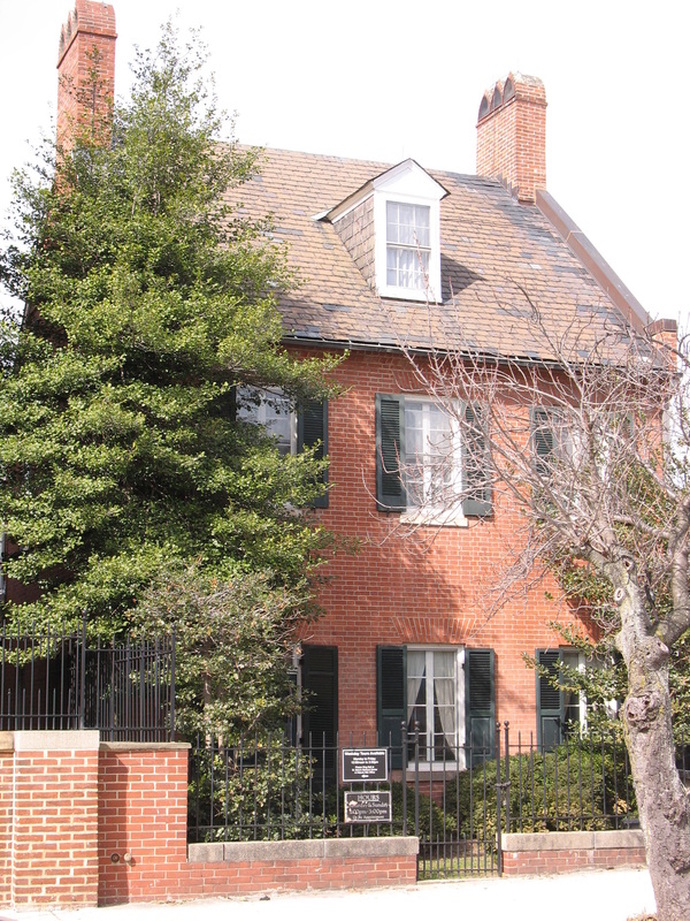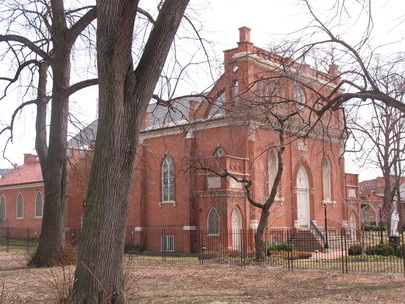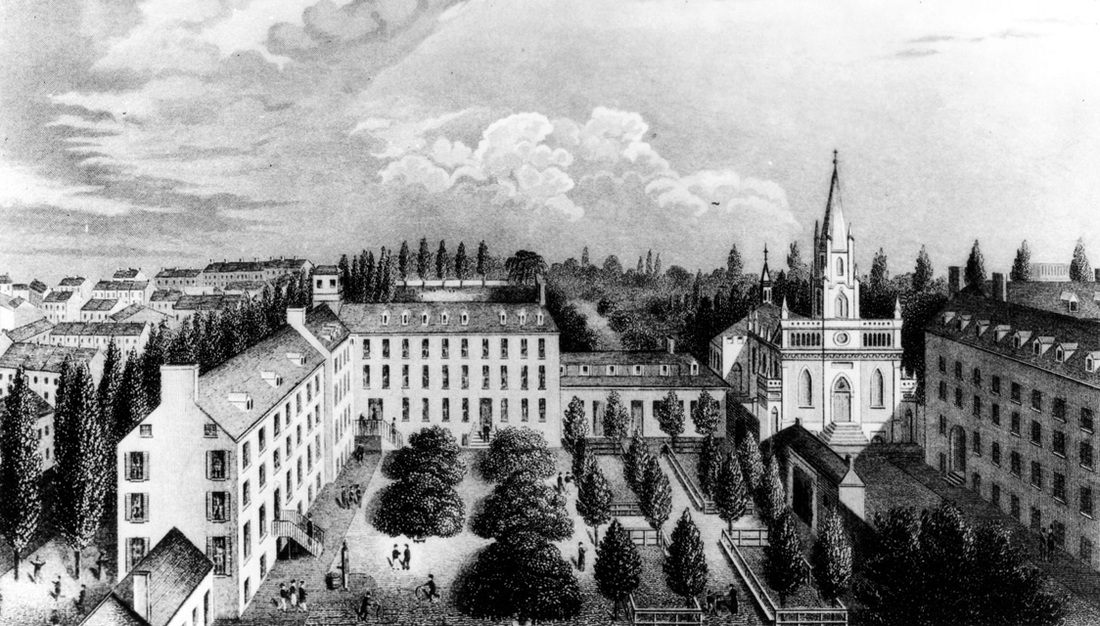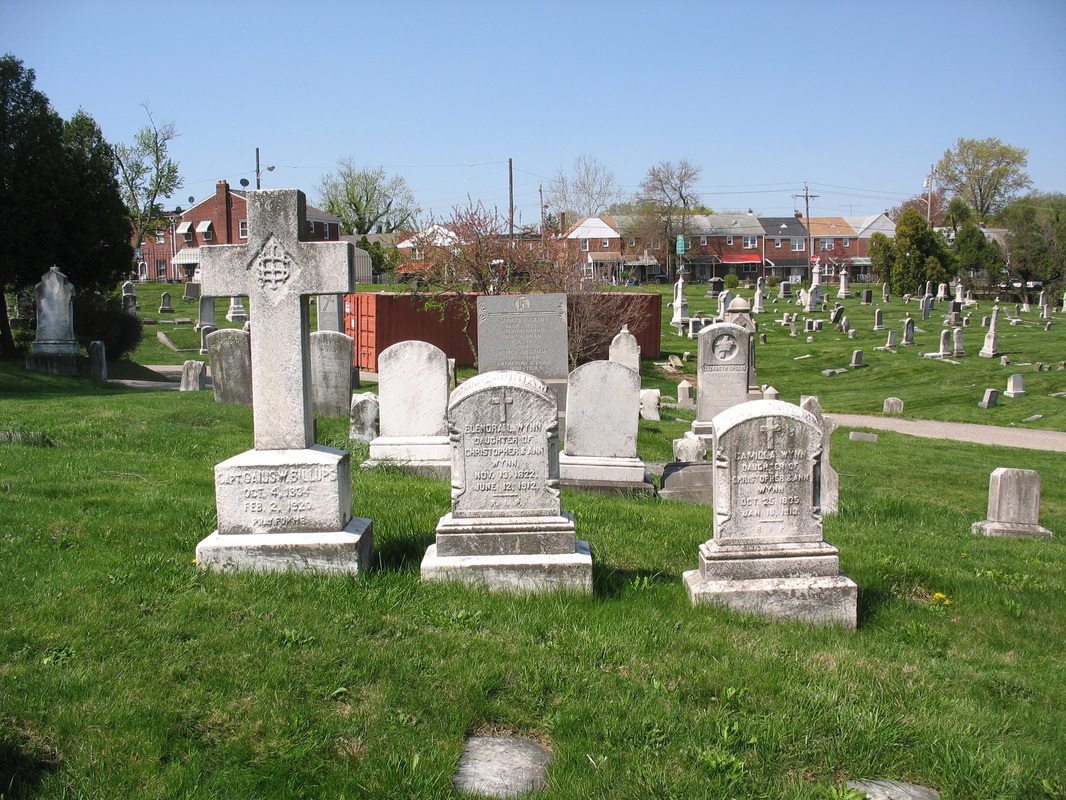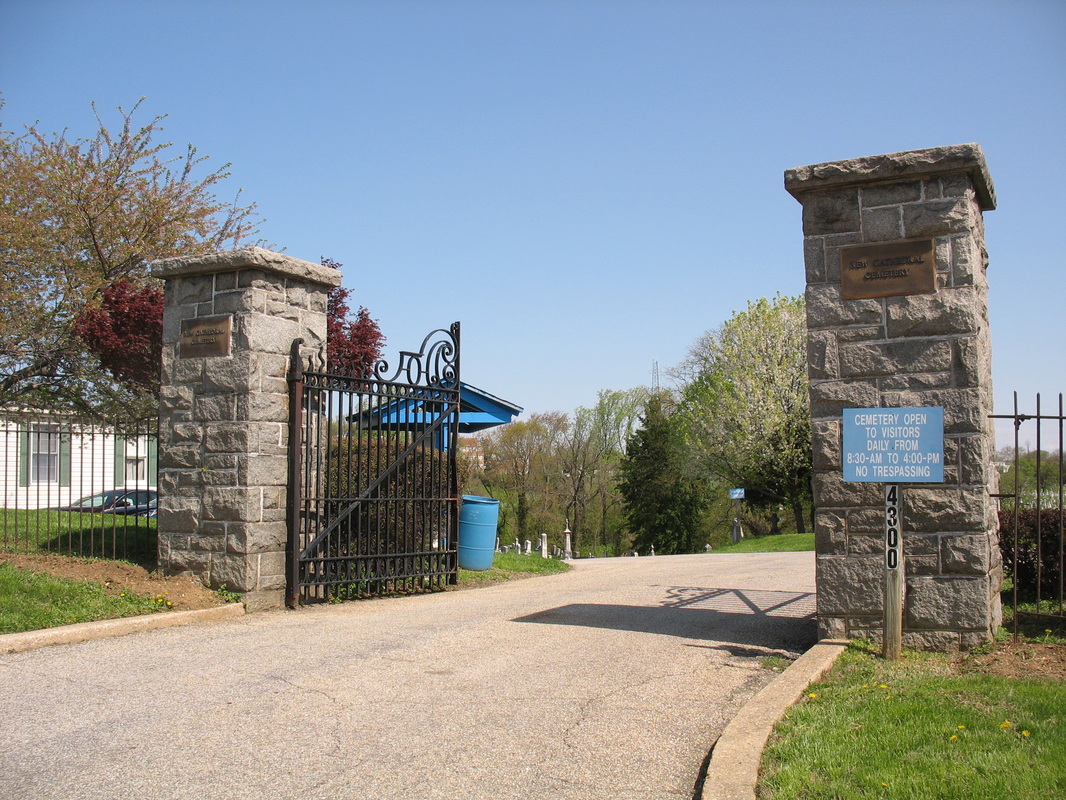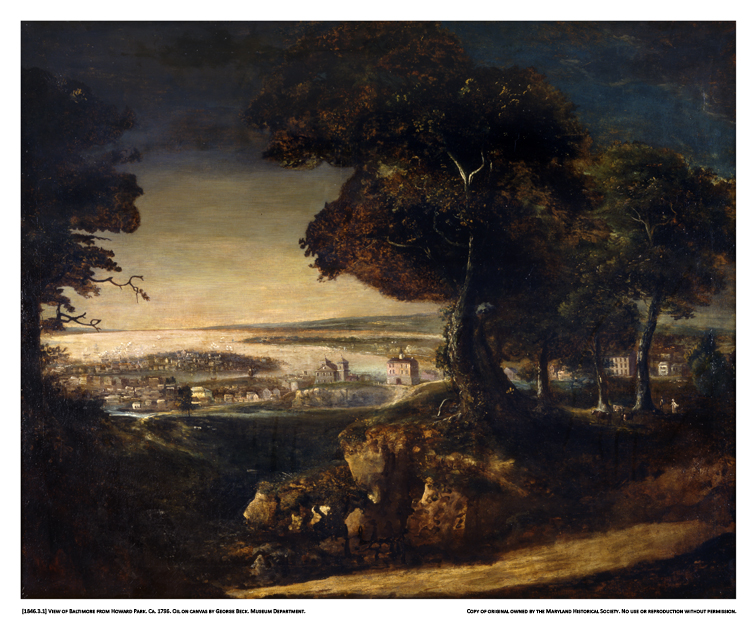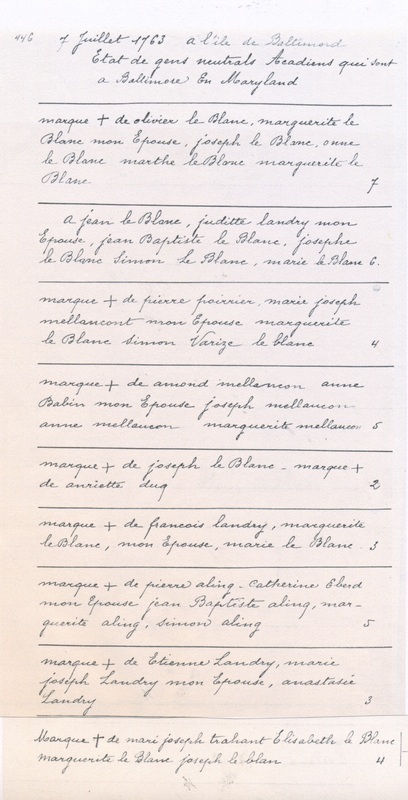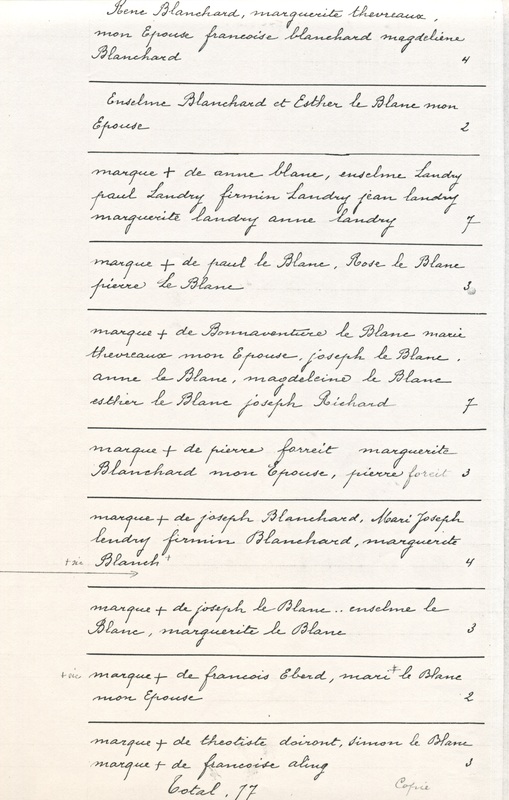Baltimore in 1752. Aquatint engraved by William Strickland, 1817. After sketch by John Moale. Hambleton Print Collection. Copy of original owned by the Maryland Historical Society. No reproduction or use without permission.
Acadians in Baltimore
|
Today’s Baltimore city limits count 620,000 residents, with an even larger metropolitan population topping 2.7 million. Quite a change from the two hundred or so who inhabited Baltimore village in 1752, on the eve of the Acadian deportation to Maryland!
Early 19th century accounts describe some of the Acadians, or “Neutral French,” seeking shelter upon their arrival in the unfinished two-story home of Edward Fottrell, located at the northwest corner of Calvert and Fayette Streets. These exiles were part of a group of over 900 who were forcibly sent from Nova Scotia to the colony of Maryland. Four vessels entered the Severn River at Annapolis in late November 1755 with the unfortunate passengers quickly redistributed to eight areas on both sides of the Chesapeake. Those 170 Acadians on the schooner Leopard were destined to ‘settle’ in Annapolis and Baltimore. Andrew Stygar and a Mr. Middleton supervised the transportation to Baltimore. |
By the end of the French and Indian War in 1763, only about 800 Acadians remained in Maryland. Seventy-seven of these -- surnamed Alain, Blanchard, Doiron, Forest, Landry, LeBlanc, Melancon and Poirier - were living in Baltimore.
Fortune allowed most of the Maryland exiles the opportunity to resettle in Louisiana in the years 1766-1769. The approximately 200 Maryland Acadians that chose to stay in the colony were joined by a few Philadelphia Acadian exiles (Bujeau, Deschamps, Gold and Wedge). Most of the remaining Maryland Acadians moved from their outlying Maryland villages to Baltimore and there joined the new Philadelphia exiles and the few remaining Baltimore Acadians. Ironically, only a minority of these 'new' Baltimore Acadians had spent the first decade and a half of exile in the city. A “French Town” developed on South Charles Street and four adjoining alleys – French Alley, Primrose Alley, Ruxton Lane and Frenchman's Alley – between Charles and Light Streets. When Baltimore tax records started appearing in 1773 and 1774, this neighborhood was known as “Westminster Hundred.” |
Gradually, Acadians prospered and reached a high point in growth in the first quarter of the 19th century. Fortunately, throughout the century, Baltimore city directories include many from the Barbine (Babin), Gold (Doiron), Guthrow (Gauterot), Wells (Dupuis), White (LeBlanc), Dashields (Deschamps), and Wedge (Aucoin) families.
Marriages also ensued with merchants, seamen and professionals such as the influential Maryland Jenkins and Rosensteel families. Throughout the 19th century (and even into the 20th), Acadian descendants can be found proudly bearing such surnames as Walter, Heuisler, Honeywell, Meredith, Hermange, Riston, Winn, Dameron, Stevens, Barbine, Piet, Martiacq, Harig and Wonn. |
Acadian Landmarks in Baltimore
Discover homes where Acadians lived and the places they may have seen during the years that followed their deportation from Nova Scotia by the British in 1755. A trip to Baltimore, Maryland is not complete without visiting the following Acadian landmarks:
1. Philpot's Point (near Philpot Street at south end of Thames Street; Douglass-Myers Maritime Park): Philpot's Point (above left) is the site where Acadians landed in early 1756, in a vessel captained by Mr. Middleton who brought them from Annapolis. From here Mr. Andrew Stygar took them to houses and businesses in Baltimore where they were sheltered.
French Town comprised Lots 36 and 39 that predominately included house numbers 17-68. Lot 36 was located where Charles Center South with the large "36" now stands. Lot 39 was across the street where the M&T Bank is now located. Originally there were four alleys (French Alley, Primrose Alley, Ruxton Lane and Frenchman's Alley) in this area; however, only one remains - French Alley. Frenchman's Alley (also called Uhler's Alley) has been incorporated into Charles Center South and West Lombard Street. Historian Greg Wood adds, "In the 1810 Baltimore city directory, I count 19 Acadian listings (some with non-Acadian male spouses) between 17 and 68 S. Charles."
3. Home of Paul Bigeo, Acadian (Thought to be #48 South Charles Street): Acadian Paul Bigeo lived in his small home on lot 36 from 1766 onward. Save for one year (1803), city directories have him in the same home from 1796 until his death in 1822. The Bigeo home was located on the west side of South Charles Street nearly opposite Primrose Alley (about halfway between French Alley and West Lombard Street). In 1801 Lombard ended at Hanover Street, west of Charles. Primrose Alley, then, is more or less the intersection of what was then #48.
 Saint Peter's Catholic Church, Baltimore. 1801. Oil on wood panel by Thomas Ruckle, Sr. Museum Department. Copy of original owned by the Maryland Historical Society. No reproduction or use without permission.
Saint Peter's Catholic Church, Baltimore. 1801. Oil on wood panel by Thomas Ruckle, Sr. Museum Department. Copy of original owned by the Maryland Historical Society. No reproduction or use without permission.
5. Interpretative Sign: The sign shows Saint Peter's Catholic Church (built 1770) and Saint Paul's Episcopal Church Rectory as they appeared in 1801. (Southwest Corner of North Charles Street and West Saratoga Street).
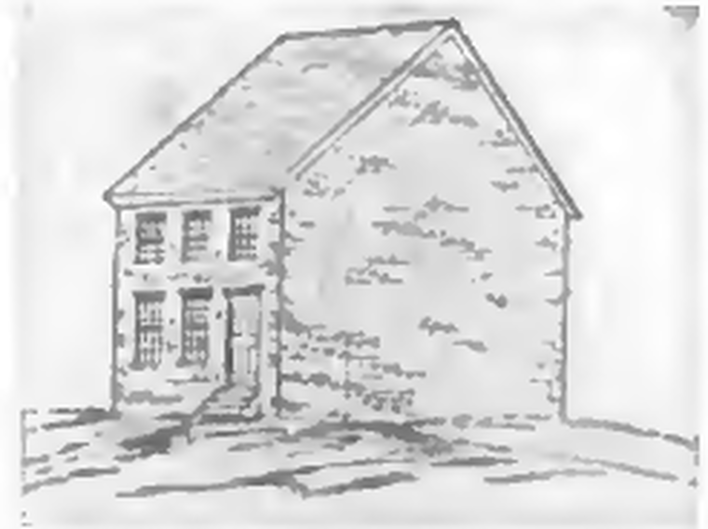 St. Peter's Catholic Church
St. Peter's Catholic Church
6. Saint Peter's Catholic Church and Pro-Cathedral (1770-1841) (Southeast corner of Little Sharp Street and West Saratoga Street): Located on the original Lot 157 purchased in 1764 by Rev. George Hunter from Charles Carroll of Annapolis for a mere £6 42s, Saint Peter's Catholic Church was built beginning in 1770 fronting Little Sharp Street. In 1790 when Rev. John Carroll was installed as Bishop of Baltimore and his See encompassed all of the then United States, the small Saint Peter's Catholic Church became his Pro-Cathedral and remained the Pro-Cathedral until 1821 when the present Basilica was consecrated as a Cathedral. Saint Peter's Church was enlarged in the 1780s and remained on this site until 1841. Today, a parking garage occupies the site. The small Pro-Cathedral Cemetery discussed below was located between Saint Peter's Church and North Charles Street. Saint Peter's Catholic Church was the first Catholic church in Baltimore.
7. Saint Paul's Episcopal Church (233 North Charles Street): The present Saint Paul's Episcopal Church is the fourth built on this site - the first serving from 1739 until 1784.
When Saint Peter's Catholic Church had to close periodically from 1773 until the late 1770s due to financial problems, Acadians of Baltimore attended services and were married at the first Saint Paul's Episcopal Church on this site. The present church on this site was built in 1856.
Wood adds, "We do know that at least 11 or so early marriages were performed there from 1778-1784. The first one that I have recorded is between Cyprian Wells and Margaret White on September 13, 1778. Five weddings are from 1780! Later on, there is an occasional wedding there, but by choice, not sporadic church ministry. It has also been stated that mass might have been said in Acadian houses on S. Charles when St. Peter’s was closed in the early 1770s. Father Bernard Diderick, a Belgian, ‘served’ Baltimore irregularly until 1783. When Rochambeau’s chaplain was in town in 1781, Acadians had complained to him about (his, presumably) lack of zeal and affection, poor singing, and once a month masses in Baltimore."
Wood adds, "We do know that at least 11 or so early marriages were performed there from 1778-1784. The first one that I have recorded is between Cyprian Wells and Margaret White on September 13, 1778. Five weddings are from 1780! Later on, there is an occasional wedding there, but by choice, not sporadic church ministry. It has also been stated that mass might have been said in Acadian houses on S. Charles when St. Peter’s was closed in the early 1770s. Father Bernard Diderick, a Belgian, ‘served’ Baltimore irregularly until 1783. When Rochambeau’s chaplain was in town in 1781, Acadians had complained to him about (his, presumably) lack of zeal and affection, poor singing, and once a month masses in Baltimore."
 St. Paul's Episcopal Church Rectory
St. Paul's Episcopal Church Rectory
8. Saint Paul's Episcopal Church Rectory (24 West Saratoga Street): Built between 1789 and 1791 to the west of Saint Peter's Catholic Church, the rectory has served the pastors and congregation of Saint Paul's for over 200 years. Little Sharp Street (an alley today) separates the Episcopal property from the historic property of Saint Peter's Catholic Church.
 National Shrine of the Basilica
National Shrine of the Basilica
9. Basilica of the National Shrine of the Assumption of the Blessed Virgin Mary (the Baltimore Basilica) (409 Cathedral Street): Designed by Benjamin Henry Latrobe and built between 1806 and 1821, the Basilica was the first Catholic Cathedral built in the United States.
The Basilica has witnessed many historical events including the funeral of Acadian benefactor Charles Carroll of Carrollton, in 1832, the only Catholic to sign the Declaration of Independence.
After 1821 the Acadians of French Town attended Catholic services and received the sacraments at this Cathedral. Rev. John Carroll, the first Bishop of the United States is buried in the Basilica's historic crypt. Rev. Carroll performed baptisms and marriages and was more than just a “supporter.” Later, he would manipulate the board of St. Peter’s to force it to sell some of its land for cathedral construction at a rock-bottom, below-market price.
The Basilica has witnessed many historical events including the funeral of Acadian benefactor Charles Carroll of Carrollton, in 1832, the only Catholic to sign the Declaration of Independence.
After 1821 the Acadians of French Town attended Catholic services and received the sacraments at this Cathedral. Rev. John Carroll, the first Bishop of the United States is buried in the Basilica's historic crypt. Rev. Carroll performed baptisms and marriages and was more than just a “supporter.” Later, he would manipulate the board of St. Peter’s to force it to sell some of its land for cathedral construction at a rock-bottom, below-market price.
In the 1770s most of the Acadians that remained in Maryland migrated to Baltimore and resettled in the area of Frenchtown. Several became mariners from the Port of Baltimore and achieved economic success over the years. Acadians valued land highly and remembered when they owned their own farms in Acadia. Thus, as “excess” funds became available in the early 1800s, these Acadians purchased land – especially in today’s Federal Hill area of Baltimore, just a short distance south of Frenchtown.
Peter Gold (Doiron) bought several lots on both the north and south sides of Montgomery Street between Charles Street and Light Street. John Germane purchased parcels on the north side of Montgomery Street between Light Street and William Street and on the north side of Montgomery Street between Charles Street and Hanover Street. Joseph Gautrot obtained a parcel on the south side of Montgomery Street at 17 West Montgomery Street between Charles Street and Hanover Street. The Barbine (Babin) family owned property on the west side of Charles Street between Lee Street and York Street. B. L. Harig and Mary Gold (Doiron) Wonn built a home on the northwest corner of Light Street and West Street. Many of the original structures on these properties were used as rental, income-producing assets for the Acadian owners.
Most of the original structures on these properties have been demolished; however, at least three buildings with Acadian ties remain. Peter Gold (Doiron) purchased the property at 740 South Light Street and, prior to 1837, constructed the building there today. An 1859 court document indicates that this building is the only structure from the estate of Peter Gold that should not be demolished. In 1837 Peter Francis Gold had a “dry goods” store here, and his future wife Margaret Bateman lived above the store. The building at 801 South Charles Street was built around 1805 and purchased by Peter Gold in 1818. A bit later in time, in 1887, B. L. Harig and Mary Gold (Doiron) Wonn built the home at 1130 South Light Street. Their son Joseph Harig lived there as well.
Peter Gold (Doiron) bought several lots on both the north and south sides of Montgomery Street between Charles Street and Light Street. John Germane purchased parcels on the north side of Montgomery Street between Light Street and William Street and on the north side of Montgomery Street between Charles Street and Hanover Street. Joseph Gautrot obtained a parcel on the south side of Montgomery Street at 17 West Montgomery Street between Charles Street and Hanover Street. The Barbine (Babin) family owned property on the west side of Charles Street between Lee Street and York Street. B. L. Harig and Mary Gold (Doiron) Wonn built a home on the northwest corner of Light Street and West Street. Many of the original structures on these properties were used as rental, income-producing assets for the Acadian owners.
Most of the original structures on these properties have been demolished; however, at least three buildings with Acadian ties remain. Peter Gold (Doiron) purchased the property at 740 South Light Street and, prior to 1837, constructed the building there today. An 1859 court document indicates that this building is the only structure from the estate of Peter Gold that should not be demolished. In 1837 Peter Francis Gold had a “dry goods” store here, and his future wife Margaret Bateman lived above the store. The building at 801 South Charles Street was built around 1805 and purchased by Peter Gold in 1818. A bit later in time, in 1887, B. L. Harig and Mary Gold (Doiron) Wonn built the home at 1130 South Light Street. Their son Joseph Harig lived there as well.
13. Fell's Point: A must stop for a variety of food, either from vendors at the Broadway Market or in the many restaurants and bars, Fell's Point is a popular neighborhood (much more animated than Little Italy!). St. Patrick's Church is located in front of the Market. There is easy walking access to everything -- including the Robert Long House (#13). Parking in some areas is restricted to two free hours and is strictly enforced. On a nice day, enjoy the many cobblestone streets and take a walk out on the Point to observe the marina and the big ships in port across the water.
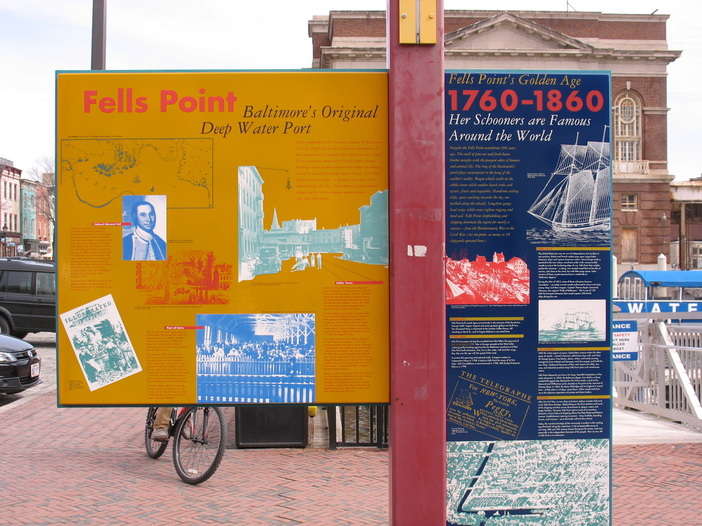 Fell's Point
Fell's Point
Located just east of today's Inner Harbor, Fell's Point developed as a waterfront community in the early 1760s along the northwest branch of the Patapsco River. Fell's Point, which still has the look and feel of the early 1800s, generally is bounded on the east by South Chester Street, on the north by Bank Street, on the west by South Eden Street and on the south by the eastern end of the Inner Harbor and the Patapsco River. In the 1790s and early 1800s over 1200 French escaping the Toussaint L'Ouverture slave revolt in Saint Domingue (today's Haiti) found refuge at Fell's Point. Within this group likely were some destitute Acadians who had resettled in Saint Domingue in the 1760s. Scholars estimate the Saint Domingan group had approximately
1000 whites and 500 mulattoes, free blacks, and slaves who came to Baltimore.
Additionally, a small number of Acadians migrated into Fell's Point from Baltimore to work in the shipyards and seafaring trade there.
Additionally, a small number of Acadians migrated into Fell's Point from Baltimore to work in the shipyards and seafaring trade there.
 The Robert Long House
The Robert Long House
14. The Robert Long House (812 South Ann Street): The oldest surviving Baltimore residence, the Robert Long House, was built in 1765 and was likely seen often by the Acadians and the French residing in Fell's Point.
16. New Cathedral Catholic Cemetery (1874-Present): The New Cathedral Catholic Cemetery is located at 4300 Old Frederick Road and contains the remains of Baltimore Catholics since 1791. The first Catholic cemetery, Pro-Cathedral Catholic Cemetery (1791-1815), was a small cemetery bounded by West Saratoga Street on the south and North Charles Street on the east. In 1815 Pro-Cathedral Catholic Cemetery was closed and many graves were transferred to the newly-constructed Cathedral Catholic Cemetery (1816-1874) on North Fremont Street at Winchester Street. The Pro-Cathedral Catholic Cemetery next to St. Peter’s was eliminated because Archbishop Carroll wanted the lot for construction of the (arch)bishop’s residence or else the cathedral property could not have been extended to S. Charles Street! St. Peter’s, although in existence until 1841, had just become too small.
Remains not relocated by relatives were placed in a mass grave at the Cathedral Catholic Cemetery. The emptied Pro-Cathedral Catholic Cemetery land was sold for building development and the Mariner Bank Building is there today.
Remains not relocated by relatives were placed in a mass grave at the Cathedral Catholic Cemetery. The emptied Pro-Cathedral Catholic Cemetery land was sold for building development and the Mariner Bank Building is there today.
In 1874 the Church trustees replaced the 12-acre Cathedral Catholic Cemetery with the 45-acre New Cathedral Catholic Cemetery established on Old Frederick Road. By 1887 all remains were moved from the Cathedral Cemetery to the New Cathedral Catholic Cemetery and the empty 12-acre tract was sold for rowhouse development which covers the site today. Most of the early graves have no markers today and their locations in New Cathedral Catholic Cemetery are unknown. Wood asserts, " I will vouch for seeing the actual headstones of Paul and Sarah (Sally)
Gold and some of their Wynn and Billups descendants. The Jenkins mausoleum on another lot there
contains the remains of several from the Jenkins-Gold family."
|
17. St. Charles College (711 Maiden Choice Lane in Catonsville, MD): St. Charles Seminary: just off the Baltimore Beltway Wilkens Avenue, east exit. Reached easily by driving a few blocks to Maiden Choice Lane and turning left. At the Charlestown Retirement Village
(a large Erickson community), pass through the security gate. The chapel and former seminary buildings are easily visible to the left. Visitor parking is limited, so it is good to have the gate attendant offer his suggestion or be lucky to grab one of the 3-4 spaces available directly in front of the chapel. The downtown Baltimore skyline can be seen from the retirement facility. |
The Our Lady of the Angels Chapel is an architectural gem in the Italian Renaissance style, and its mosaics, dome, marble, and high nave please the eye. One of its beautiful stained glass windows, designed by Charles J. Connick, honors Rev François Nagot, first head of Sulpician Seminary on Paca Street, and Acadian descendant Oliver Jenkins, the first head of the St. Charles Minor Seminary, Ellicott City.
|
Remaining buildings of the second St. Charles College, a minor seminary established by the Sulpician Fathers in 1848 for the purpose of training young men for the priesthood, may be found on the grounds of what is now the Charlestown Retirement Community. The original seminary was first built near Doughoregan Manor (just outside Ellicott City) on land donated by the Acadian friend Charles Carroll of Carrollton who lived at the Manor. Rev. Oliver Jenkins, the first president of St. Charles College, was an Acadian descendant of the Gold (Doiron) family. Father Jenkins served St. Charles College during its first two years and again from 1852-1869. In 1911 the original seminary burned and was quickly reconstructed at this site in Catonsville.
Acadians Sail for Louisiana's St. Gabriel Parish on the Schooner La Vierge (1767)*
|
Item no. 2222a. Records of the French Superior Council at the Louisiana State Museum in New Orleans. The Sale of the Schooner La Vierge that brought St. Gabriel Acadians to New Orleans from Maryland, 8 August 1767, p.1
| ||||||
|
Item no. 2222. Records of the French Superior Council at the Louisiana State Museum in New Orleans. The Sale of the Schooner La Vierge that brought St. Gabriel Acadians to New Orleans from Maryland, 8 August 1767, p. 1a
| ||||||
|
Item no. 2222. Records of the French Superior Council at the Louisiana State Museum in New Orleans. The Sale of the Schooner La Vierge that brought St. Gabriel Acadians to New Orleans from Maryland, 8 August 1767, p. 2
| ||||||
|
Black Box 102, June-August 1767, 140 Schooner La Vierge.
Acadians, p. 1 Black Box 102, June-August 1767, 141 Schooner La Vierge.
Acadians, p. 2 | ||||||||||||
*La Vierge source documents are from the Records of the French Superior Council of Louisiana (Nos. 2222 and 2222a). Published Courtesy of the Louisiana State Museum Collections Historical Center - Item No. 2222, 8 August 1767. The French term La Vierge means The Virgin in English.
Acadian Surnames of Baltimore (1756-1769)
|
|
|
Acadian Surnames of Baltimore (1773-1830s)
|
|
|
Acadians in Baltimore (1763)
Published Courtesy of Library and Archives Canada
Note: To magnify the above document(s), using Chrome, right mouse click on the document and select "Open image in new tab." Or in Firefox, right mouse click on the document and select "View Image." Then use your magnifying glass to enlarge the print. In IE, use the standard "zoom" feature to enlarge your page. In Safari, right mouse click on the document and select "Open Image in New Window." Also, by clicking CTRL and then the + / - keys you may enlarge or reduce the size of any page on the site.
Note: To magnify the above document(s), using Chrome, right mouse click on the document and select "Open image in new tab." Or in Firefox, right mouse click on the document and select "View Image." Then use your magnifying glass to enlarge the print. In IE, use the standard "zoom" feature to enlarge your page. In Safari, right mouse click on the document and select "Open Image in New Window." Also, by clicking CTRL and then the + / - keys you may enlarge or reduce the size of any page on the site.

